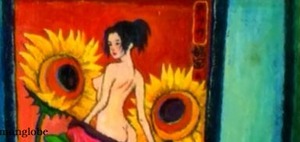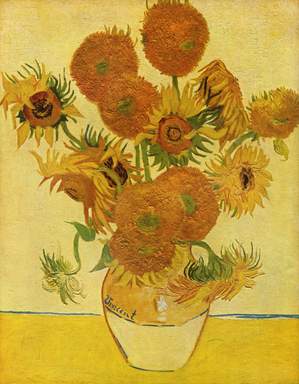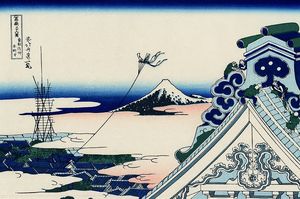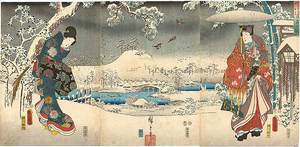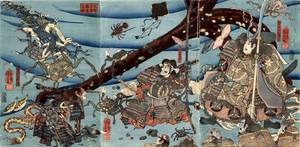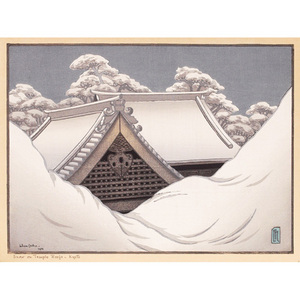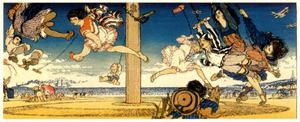Yesterday I went to the Legion of Honor to see the Japanesque exhibit. As everyone reading this should be aware, I am a big fan of Japan so I was excited to see the exhibit. For those not up on their Japanese art history, when Japan was opened to the west by the Black Ships of Commodore Perry in 1854, art made a rapid incursion into the sophisticated circles of Europe. France, in particular, got wicked excited by ukiyo-e (woodblock prints) and artists such as Hokusai and Hiroshige (two of the most famous and influential artists in Japan during the ukiyo (“floating world”) period. In case you caught the whole repetition of ukiyo there, the “-e” on the end indicates “picture” or “print” so the literal translation is actually “print of the floating world”, but they were all made with woodblocks back then so that’s why it’s translated like that generally.
Back to the point. France got all revved up by Japanese art so they decided as a homage to copy it for like the next 50 years. Lots of the text at the museum made it sound nicer in the curated displays. Like, “This picture alludes to the print by Hokusai (also in this exhibit) by repeating the motif of the roof top of a religious institution in the foreground with a truncated view of the blah blah blah..” Sometimes it would also be all “Art connoisseurs would have immediately recognized the reference to blankity-blank…” This kind of talk got boring fast. It’s not that it wasn’t interesting and comparing some of the works was intriguing but it got repetitive quickly. The entry point for the exhibit also had several pieces hung next to one another. For example, one Japanese print next to a painting by Mary Cassat comparing the subjects and viewpoints. I was worried the entire exhibit would be like that and I wouldn’t be able to appreciate anything just on its own as I would be continuously having to compare art based on the curator’s placement decisions. Luckily that was only like 8 pieces at the beginning.
Side-note story! My knowledge of French Impressionism drawing extensively on Japanese prints came sort of from Asian Studies classes but mostly from anime. Yup. Anime teaches me many, many things. In an episode of Samurai Champloo, a woodblock printer makes a picture of sunflowers and the lead female character (naked because porn was also very popular back then) and it’s shipped to Europe where Van Gogh eventually gets his hands on it and makes his famous sunflower painting.
Image taken from Van Gogh Paintings
As it was a Sunday when I went it was super crowded in the special exhibit area. I’ve never been to the Legion of Honor when it’s actually crowded, I don’t think. But generally I go in the middle of the week. I’ve always loved the LoH best out of the museums in SF because it’s not crowded, neither in the rooms or on the walls. So feeling the mass of humanity on all sides while trying to appreciate relatively small Japanese woodblock prints on the walls was slightly unpleasant.
One of my favorite parts of the exhibit was the comparisons between Hokusai’s Thirty-Six Views of Mt. Fuji and the Thirty-Six Views of the Eiffel Tower by Henri Riviere. Two of my favorites from these series were Mt Fuji from Hongen Temple and the Eiffel Tower from Notre Dame.
I also really liked the collaborations between Hiroshige and Kunisada. Kunisada was famous for people and Hiroshige for landscapes/backgrounds so together combined they were gorgeous. They did two I really liked based on Murasaki and her Tale of Genji. Also one from a series called Two Artists Tour the Seven Hot Springs.
Image taken from Hiroshige.org
Note: This one not at LoH but I couldn’t find any of the ones that were. This is from the Elegant Prince Genji series though.
My other two favorite Japanese prints on display were Utagawa Kuniyoshi’s Taira Ghosts Preparing to Attack Yoshitsune:
Image taken from Kuniyoshi Project
And Hiroshige’s Night View of Matsume Hill. The cool thing about this one is that the artist left in the wood grain. The natural grain was transferred to the print during the baren rubbing process and was highlighted in the sky. So pretty. I can’t find this specific picture online but if you want to see another one and read about woodgrain patterns, go here.
Want to know how I know the word for the rubbing tool? My second favorite part of the exhibit was a video describing how woodblock printers do their work. I watched them create tools, cut and carve wood and print onto special rice paper. It was completely engrossing. There’s going to be a live demonstration on December 11 by a master and I want to go back to see it. Anyone up for joining?
Finally, part of the exhibit also included contemporary wood-print designs made by Americans. The vast majority of these (surprisingly) were female. Certainly, I liked the female artists more than the modern male ones. These included: Bertha Lum, Helen Hyde, and Lillian May Miller.
Image taken from Treadway Gallery–that’s a Miller and is in the exhibit at LoH
One of the male contemporary woodblock artists was incredibly impressive though and that was John Edgar Platt who did The Giant Stride:
As I’ve already told Jacob (who’s also been to the exhibit already), I now have my own dream of trying out woodblock printing. I am relatively confident that I can accomplish this without losing a finger. I am not confident I can make my own baren. I’m still looking into this dream.
